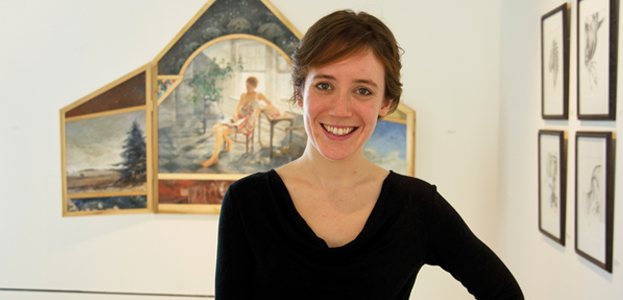
UMaine Student Finds Her Voice in an Ancient Art Form
Artist Caroline Robe describes the past year in two words: tough love. Tough, because she began a self-study of one of the most archaic, difficult painting mediums — egg tempera. Love, because the arduous journey resulted in unequivocal success in an art form that she says suits her personality and her voice.
“I’m inclined to be less urban, off the beaten path,” says Robe, a University of Maine student from Waterville, Maine, who completed her studio art degree last December. “Egg tempera is an old painting style that’s not common and not designed for ease. But it’s a very conceptual medium.
“Using a medium that requires so much preparation indulges my interest in manual processes and allows for a great range of expression — from the earliest stages of building the birch panel to the final thin glazes.”
In fall 2011, Robe discovered her passion for what is considered one of the oldest painting mediums when she studied abroad at the Aegean Center for the Fine Arts in Greece.
“The experience opened me up to following my own path and trusting my intuition,” she says. “I realized this is something I could do for the rest of my life.”
For a month, Robe also traveled through Italy, studying pre-Renaissance and Renaissance art, with particular interest in the egg tempera works that used pigments mixed with a binder — egg yolk — to make paints that were applied in multiple glazes to rigid support surfaces, such as boards. When she returned to UMaine, she established a studio in her Orono apartment and started her honors thesis — an exploration on modern-day egg tempera painting.
“Egg tempera is a technical process that results in unparalleled beauty. It has a romance to it,” says Robe. “In the 13th to 15th centuries, it was meant to be a literary art. And that’s what I wanted to do through my artwork — tell stories.”
In her self-study of the technically difficult egg tempera painting process, Robe consulted her thesis adviser Ed Nadeau and took an independent study with James Linehan, both UMaine artists and professors. She read countless books on the medium.
She also studied the works of the 20th-century master of egg tempera — Andrew Wyeth. And she trusted herself “to find my own way in this medium.”
“Egg tempera doesn’t imitate the lushness of reality like oil. It’s linear, flat and smooth, inviting the viewer to interact with the painting in a more intellectual, conceptual way,” Robe says.
Within a year, Robe found her own means of expression in egg tempera — from making her own paints to building her 8-foot by 5.5-foot narrative panels.
“In the large narrative works like my thesis painting (titled “For you I bring with reverent hands, beauty won from darkest hours”) there’s a lot of symbolism and personal mythology,” Robe says. “It is a narrative of transformation. It’s about falling in love with vernacular space.
“This also is feminist artwork — a narrative about women and my own empowerment. Creating this large egg tempera was a feminist act. There are few egg tempera female painters. Even when it was particularly challenging, I felt it necessary to go past self-censoring to show that young females can make big paintings, do big things, too.”
Robe admits that there were times early on in her year of self-guided study that the challenges seemed insurmountable and she contemplated switching mediums.
“When (Sandro) Botticelli was doing it (in the 15th century), he had a shop full of assistants helping him,” she says. “There’s a lot in the process that takes time, but I needed a challenge.
“Now it’s transformed my identity, from an average level of commitment by a college art student to an artist who is rabidly invested in doing this work,” says Robe, who hopes to return for more study in Europe and eventually to pursue a Master of Fine Arts. “For me, it is the intersection of daily life, peace and women’s activism.”
Contact: Margaret Nagle, 207.581.3745
